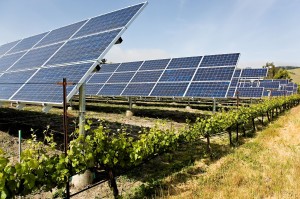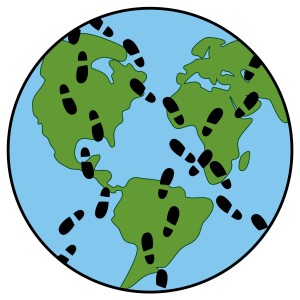Today we have a guest post from Mark Rashap, CWE. Mark tells us about the environmental impact of the wine industry, and what can be done to minimize the carbon footprint of wine.
Last year’s Paris Climate Conference—COP21—can perhaps best be described as a bumpy ride at best. There were several political sticking points, including financing the reforms needed to combat climate change and holding developing countries to the same standards as developed countries. In the end, the media was left trying to make sense of whether any true progress occurred toward the goal to cap the global average temperature increase to 2 degrees Celsius.
This type of global bickering might seem laughable to the small time grape grower, but many in the wine business—from small wineries to regional associations—are attempting to take substantial steps reduce their carbon footprint, and perhaps, by doing so, help the cause of global warming. At the very least, the COP21 got the world talking about and focusing on carbon emissions, so let’s do our part and look at what stages of the winemaking process cause green house gases (GHG) and what progressive wineries are doing to combat them.
Starting in the vineyard, we see that the pure act of growing grapes, as well as agriculture in general, has the ability to absorb carbon and GHGs. In 2015, a case study based in several Tasmanian vineyards did an incredible job at targeting the GHGs produced by wine production and recommendations to limit them. They estimated that on average growing grapes produces 1.5 tons of CO2e (carbon equivalents) per hectare per year which is only 1-2% of the emissions of the total wine production. While this is obviously a small percentage of the total GHG production, there are definitely ways to reduce this. The largest culprit by far is the fuel needed to power vineyard equipment such as tractors, sprayers, and plows, which account for 55-90% of total vineyard emissions. Any way to limit the passing of this equipment through the vineyard is the most effective first step and can include: applying fertilizers through the drip irrigation system, sowing low growth grasses in between the rows, allowing animals to graze on these grasses, updating equipment for fuel efficiency, etc.
The next biggest culprit, producing up to 30% of vineyard GHG production, is the electricity needed mostly to power pumps for irrigation. Therefore, vineyard managers must make sure that their pumps are efficient and not wasting water where it is not needed. Additionally, the use of mulches and various organic matter applications that aid in soil moisture retention will reduce reliance on the irrigation pumps. Organic and biodynamic viticulture also avoids the use of inorganic Nitrogen based fertilizer, which can breakdown in the soil and produce Nitrous Oxide, a GHG that is 298 times as harmful as Carbon Dioxide (expressed as 298 CO2e).
During the COP21 climate talks, there was one session focused on wine production with representatives from Fetzer, Concha y Toro, Moët Chandon, Smith Haute Lafitte, and Château Maris. Fetzer pledged to be carbon neutral by 2016. Their facility runs 100% on solar and renewable energy, by way of 75,000 square feet of solar panels on the roof. They are aiming to be zero waste, based on their efforts in composting, super-efficient cleaning systems, and treating waste water.
Packaging and transportation is considered the main contributor to GHGs for the wine industry. As far as packaging, the fabrication of the bottle is the biggest cause of emissions; however, reducing the weight and increasing the percentage of recycled material will limit the impact. In Champagne, the CIVC has introduced a new lighter weight bottle that that almost all wineries have adopted. This change – from 900 g to 835 g; a 7.2% decrease – over an entire region is a substantial reduction; plus, it is cheaper to make and ship but still able to withstand the pressure. As far as bottle closures go, cork has the lowest carbon footprint, about equal to 1 gram CO2 per bottle which edges out the synthetics and screw caps.
A 2007 study published by the American Association of Wine Economists, pegged transportation of finished wine as the greatest GHG contributor and analyzed the carbon footprint for the various methods of shipping. Measured in grams of CO2 per ton of cargo per kilometer traveled, the carbon footprint of the various modes of transport are as follows: 52 for container shipping, 67 for refrigerated container shipping, 200 for trains, 252 for trucks, and 570 for air freight. In essence, there is a sincere environmental cost to 2 day air shipping your next wine club installment. Additionally, many large retailers are buying in bulk from various regions and bottling the wine closer to the market. While the motivation for many of these innovations and choice in shipping is financial cost, there is an environment factor associated.
Despite the tricky politics involved in environmental protection on the worldwide stage, we in the wine business will be glad to know that there is serious progress being made in the industry to identify and improve the carbon footprint and environmental impact of our favorite wines. Shipping will always be a GHG contributor, because we love wine from all over the world and are willing to pay for it. However, better knowledge, innovation, and a commitment to reporting and improving will raise the bar for the entire industry. Santé to that!
 Post authored by Mark Rashap, CWE. Mark has, over the past ten years, been in the wine world in a number of capacities including studying wine management in Buenos Aires, being an assistant winemaker at Nota Bene Cellars in Washington State, founding his own wine brokerage, and working for Texas-based retail giant Spec’s as an educator for the staff and public.
Post authored by Mark Rashap, CWE. Mark has, over the past ten years, been in the wine world in a number of capacities including studying wine management in Buenos Aires, being an assistant winemaker at Nota Bene Cellars in Washington State, founding his own wine brokerage, and working for Texas-based retail giant Spec’s as an educator for the staff and public.
In August of 2015, Mark joined the team of the Society of Wine Educators as Marketing Coordinator to foster wine education across the country.
Are you interested in being a guest blogger or a guest SWEbinar presenter for SWE? Click here for more information!
References
- Tas Farming Futures 2015 Case Study: http://dpipwe.tas.gov.au/Documents/Clover%20Hill%20Case%20study%20FINAL%20Aug15.pdf
- http://www.sustainablewinegrowing.org/docs/CSWA%20GHG%20Report_Final.pdf
- Fetzer: fetzer.com/commitment
- CIVC: http://www.champagne.fr/en/from-vine-to-wine/grape-varieties-vineyards/sustainable-viticulture/energy-climate-challenge
- Colman, Tyler and Pablo Pastor: “Red, White, and ‘Green:’ the cost of carbon in the global wine trade.” American Association of Wine Economists. October, 2007.


